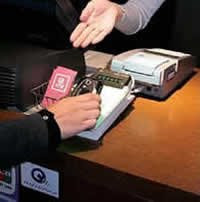
 The second model will be direct mobile billing. This model is where the consumer views the ecommerce site to make a payment. It involves two factor of authentication which is PIN and One-Time-Password, then the consumer's mobile account is charged for the purchase. The example would be Mobile Money.
The second model will be direct mobile billing. This model is where the consumer views the ecommerce site to make a payment. It involves two factor of authentication which is PIN and One-Time-Password, then the consumer's mobile account is charged for the purchase. The example would be Mobile Money.The third model would be mobile web payment (WAP). This model is where the consumer uses web pages displayed or additional application the consumer downloaded and installed on the mobile phone to make a payment.
The last model will be contactless near field communication. This is a method that is mostly used for making purchases in physical stores or transportation services. The mobile phone is equipped with a smartcard and when the consumer waves the mobile phone near a reader module. Most transaction does not require authentication but some require PIN for safety purposes before the transaction is done. The payment could be deducted from the mobile phone or directly to the bank account. 
Mobile payment system may be good for users but there are pros and cons for it. In pros, consumers would not require to bring cash out for their daily life. This will provide convenience for consumer. Other than that, it is also easy to use and a simple wave or a click of a button then the request will be send and the transaction is completed in a few minutes. On the other hand, in the downfall, there is risk as it is unsafe when some transaction does not request authentication and it will be easily fraud as long as the mobile phone is stolen. Other than that, mobile payment system is still not yet as modernize in certain country, so it is not a common method to be used or applicable.
 Although mobile payment system can be useful on many circumstances, this payment system is not popular in Malaysia as Malaysian is spoiled by many other attractions. For example, credit card is a more common payment system and easier to use. The other reason that mobile payment system is not popular in Malaysia is because there is not much development in mobile commerce. Unlike the Philippine, a country where mobile commerce is the most successful implemented because of the inconvenience in making bank transaction.
Although mobile payment system can be useful on many circumstances, this payment system is not popular in Malaysia as Malaysian is spoiled by many other attractions. For example, credit card is a more common payment system and easier to use. The other reason that mobile payment system is not popular in Malaysia is because there is not much development in mobile commerce. Unlike the Philippine, a country where mobile commerce is the most successful implemented because of the inconvenience in making bank transaction.
No comments:
Post a Comment